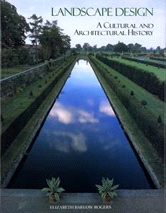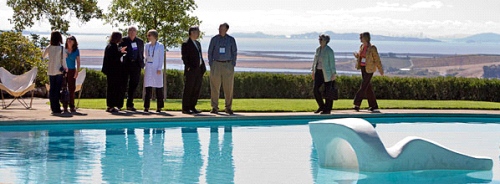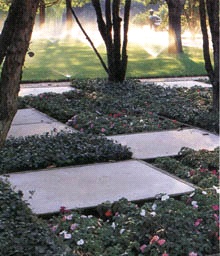Marin Modern - Heroes of Modern Landscapes II
Posted by Robert Leeper on Monday, May 24th, 2010 at 8:46pm.
The first thing I thought about writing for this blog was a brief history of landscape design during the Mid-Century Modern period. Whenever I need to learn - or refresh my learning - about landscape design, I turn to Elizabeth Barlow Rogers' encyclopedic masterpiece, Landscape Design: A Cultural and Architectural History. If it isn't in there, it hasn't happened yet! And even though her website says it took her ten years to write, I secretly think it must have taken twenty - this book weighs a ton, and has over 500 pages of very dense text and hundreds of pictures. If you want to learn anything about landscape architecture, this is your textbook!

My other favorite resource is the remarkable Cultural Landscape Foundation whose mission is "dedicated to increasing the public's awareness of the important legacy of cultural landscapes and helping save them for the future." We are very fortunate to have a foundation that is dedicated to educating the public about important landscapes, and actually helps preserve them. Visit this site to learn, and please support their mission.

OK - on to Modernism! So, after a quick refresher course, here - in my own words - is what I relearned about the history of landscape design during the mid-century modern period:
There are many designers and writers who helped create the aesthetic of Mid-century Modernism. For this blog post, I am going to just talk about four in particular. They stand out as the best known names in Landscape Modernism: Garrett Eckbo, Dan Kiley, Thomas Church, and James Rose.
All of these designers were attracted to the new ideas about architecture that were the emerging during this period. They were articulate about their profession; they all wrote articles as well as practiced. Design was about ideas and ideals, about how the designed environment made a difference in people's lives, and were significantly more important than just aesthetics alone.
All previous "styles" were rejected as ornamentation. It could be argued that the previous styles were definitely the product of their time, with their own meanings - and not just set decoration. Modernism, however, sought to reduce the designed environment to it's minimally necessary elements, integrate interior and exterior spaces, and transform design from the past to the present. It was an evolution from - and some would say a rejection of - all that came before it. It wasn't this style or that style, it was the "un"-style, to borrow a line from 7-up's advertising.
These four designers took clues from the Bauhaus, Le Corbusier, and social thought of the day, and made a bold new statement about what a landscape could be. They integrated a new way of living - which is was what we now call creating outdoor rooms - into their designs. Aesthetically, they used plantings and materials to create spaces and gave the emerging profession of landscape architecture its cornerstone. Landscapes were not meant to dress up, ornament or embellish architecture; landscapes became architecture.
 Garret Eckbo was raised in the Bay area, and studied Landscape Architecture at UC Berkeley and later Harvard. He wrote a book in 1950 called Landscape for Living which addressed ideas of modernism in the landscape, especially how to make public housing more humane with thoughtful landscape design. He practiced primarily in California. He had many outstanding designs - including the Ocotillo Lounge in Palms Springs - but his greater contribution to the profession was his continuous writings about it. He wrote throughout his career, helping give definition to the emerging field of Landscape Architecture. He helped conect everyday people to the meaning, and practice, of landscape design.
Garret Eckbo was raised in the Bay area, and studied Landscape Architecture at UC Berkeley and later Harvard. He wrote a book in 1950 called Landscape for Living which addressed ideas of modernism in the landscape, especially how to make public housing more humane with thoughtful landscape design. He practiced primarily in California. He had many outstanding designs - including the Ocotillo Lounge in Palms Springs - but his greater contribution to the profession was his continuous writings about it. He wrote throughout his career, helping give definition to the emerging field of Landscape Architecture. He helped conect everyday people to the meaning, and practice, of landscape design.  Dan Kiley was an interesting link between the past modernism. He utilized grid geometry in his designs that were similar to what Andre LeNotre did at Versailles for Louis XIV but without any ornamentation, nor any direct axis pointing to one person's power over a landscape. His designs look like circles on graph paper and are random squares, lines and orchard-like plantings of trees. This geometric layout - in real-time, on the ground, as experienced by you and I - was a clever way to create spaces, or rooms. There were hallways to walk through, orchards to meander in, and "living" rooms to relax and be with one another. His most famous mid-century modern residential landscape was The Miller Garden in Columbus, Indiana, with a house designed by Eero Saarinen.
Dan Kiley was an interesting link between the past modernism. He utilized grid geometry in his designs that were similar to what Andre LeNotre did at Versailles for Louis XIV but without any ornamentation, nor any direct axis pointing to one person's power over a landscape. His designs look like circles on graph paper and are random squares, lines and orchard-like plantings of trees. This geometric layout - in real-time, on the ground, as experienced by you and I - was a clever way to create spaces, or rooms. There were hallways to walk through, orchards to meander in, and "living" rooms to relax and be with one another. His most famous mid-century modern residential landscape was The Miller Garden in Columbus, Indiana, with a house designed by Eero Saarinen. Thomas Church wrote a book in 1955 called Gardens are for People where he dispensed practical advice on landscaping for homeowners, even those with modest homes. He went to school at Berkeley, and then Harvard, and returned to practice throughout California. His most seminal work is the Donnell Garden (pictured above), which is located in Sonoma. The website for The Cultural Landscape Foundation says the following about the design:
"At the Donnell garden, Church responded to the particular characteristics of site and client while exploring new forms. Of particular note was the biomorphic kidney-shaped pool; its Adaline Kent sculpture which functions both as a focal point and a tiny, inhabitable island; and the floating deck, designed with a checkerboard of wooden boards that preserved existing trees while extending the outdoor living space."
James Rose is the most unconventional of the group. While all were educated at Harvard's Graduate School of Design, and were friends - they were even called The Four Horsemen of Harvard - only Rose did not finish there. He was expelled! All of the modernists were interested in the revolutionary turns of architecture, landscape architecture and social issues, and they often co-wrote articles discussing these important developments. But he was expelled likely for his bucking the program being taught as too rooted in the past. Now that's what I call a commitment to one's beliefs. He was also different in his practice, doing mainly residential work, and being onsite as each was built, crafting instead of drafting, so to speak. This difference of made his work more personal, and he held tightly to his ideals. Ms. Rogers sums his philosophy up nicely:
"Like the architect Richard Neutra, Rose considered the separation between indoors and outdoors as a series of transparent planes, and his interlocking of exterior and interior forms promoted spatial fusion."
I like that word - fusion. It shows up on The Cultural Landscape Foundations' website when describing him also. We'll call James Rose the Fusionist. There is also a website devoted to him, called The James Rose Center.
Next Marin Modern blog post: Roberto Burle Marx, the only landscape designer to have a show featuring his work at The Museum of Modern Art, if you don't count the garden there, designed by Isamu Naguichi.
Robert Leeper is a guest blogger on landscape design for Marin & San Francisco Modern. He is the founder of Robert Leeper Designs, a landscape design firm established in Austin Texas which recently expanded to Marin County, California. Contact Robert at 415-322-9254 or visit him online at Robert Leeper Designs.
Robert Leeper is a guest blogger on landscape design for Marin & San Francisco Modern. He is the founder of Robert Leeper Designs, a landscape design firm established in Austin Texas which recently expanded to Marin County, California. Contact Robert at 415-322-9254 or visit him online at Robert Leeper Designs.






